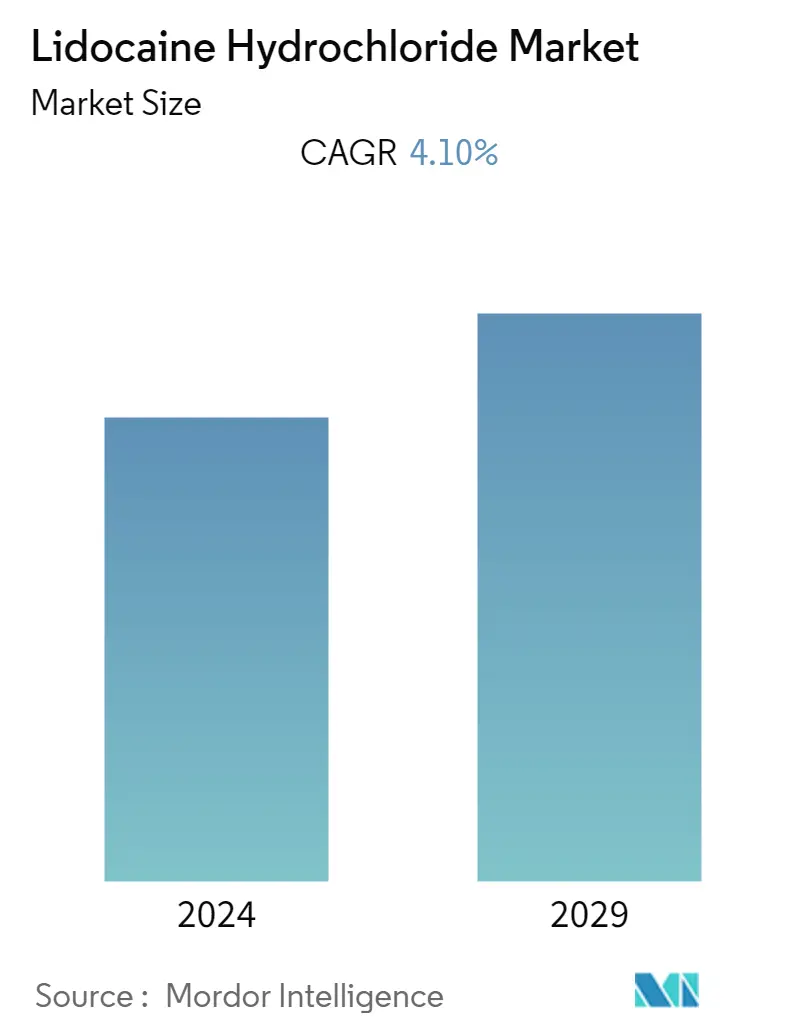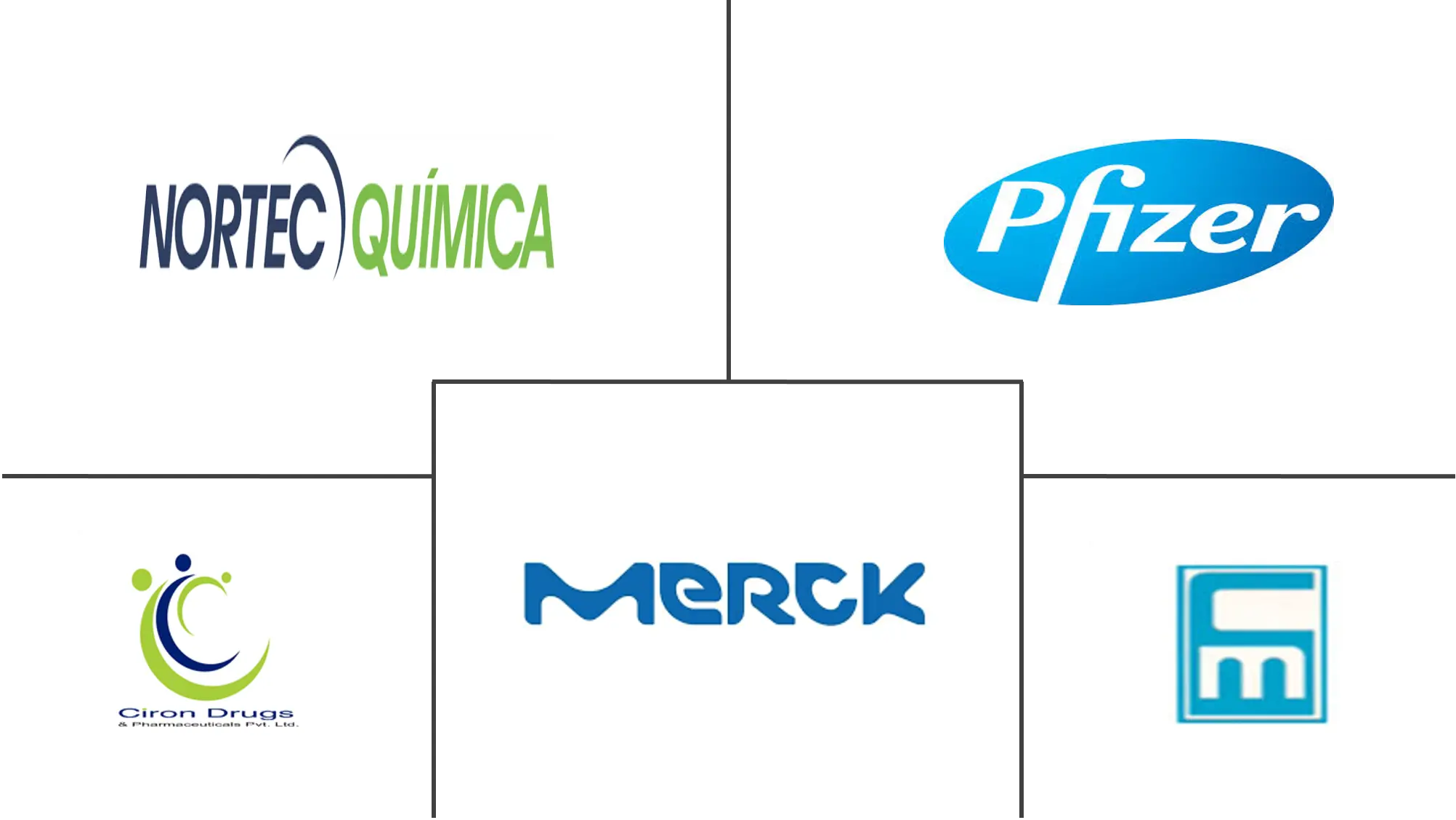Market Size of Lidocaine Hydrochloride Industry

| Study Period | 2021 - 2029 |
| Base Year For Estimation | 2023 |
| Forecast Data Period | 2024 - 2029 |
| CAGR | 4.10 % |
| Fastest Growing Market | Asia Pacific |
| Largest Market | North America |
Major Players
*Disclaimer: Major Players sorted in no particular order |
Lidocaine Hydrochloride Market Analysis
The lidocaine hydrochloride market size is expected to record a CAGR of 4.1% during the forecast period.
COVID-19 had an impact on the growth of the market during the pandemic period owing to the potential anesthetic and anti-inflammatory properties of lidocaine in COVID-19. For instance, according to the Springer article published in March 2021, it was proposed that nebulized lidocaine might be beneficial in reducing cytokines, protecting patient's lungs, and improving outcomes in COVID-19 patients when administered via inhalation as an adjunctive treatment for severe respiratory symptoms in patients fighting the novel coronavirus. Thus, the potential benefits of lidocaine hydrochloride in the treatment of COVID-19 patients had an impact on the growth of the market. Moreover, the relaxation of strict regulations on surgical procedures in the post-pandemic period and the resumption of services are expected to drive the demand for lidocaine hydrochloride, thereby boosting market growth over the forecast period.
The increase in the number of surgical procedures performed worldwide, including dental procedures, cosmetic surgeries, and plastic surgeries, is expected to promote growth owing to the vast anesthetic usage of lidocaine hydrochloride in the surgeries. In addition, the rise in chronic and acute pain-related disorders and various benefits associated with lidocaine hydrochloride are some of the major factors driving the market growth. For instance, as per the Aesthetics Society 2021 report, there were around 3.2 million aesthetic procedures performed in 2021 in the United States. Additionally, the prevalence of pain-related disorders such as epilepsy and heart arrhythmia among the global population is also one of the driving factors for the growth of the market owing to the anti-inflammatory and pain reduction properties of lidocaine hydrochloride. For instance, as per the WHO data published in February 2022, around 50 million people worldwide have epilepsy, and an estimated 5 million people are diagnosed with epilepsy each year. Furthermore, additionally, the NCBI article published in May 2021 mentioned that in Europe, prevalent atrial fibrillation cases were expected to reach 14 million by 2060. Such prevalence of target diseases among the global population is expected to drive the growth of the studied market over the forecast period.
Additionally, the rising product launches by various market players are also expected to contribute to the growth of the market over the forecast period. For instance, in April 2022, Alembic Pharmaceuticals, wholly-owned Aleor Dermaceuticals, received final approval from the United States Food and Drug Administration for Lidocaine for use on normal intact skin for local analgesia and genital mucous membranes for superficial minor surgery. Further, owing to their safety profile and proven efficacy, lidocaine patches have been recommended as first-line therapy for the treatment of neuropathic pain in older patients, as well as those suffering from shingles, and this is expected to boost the market growth during the forecast period. Therefore, due to the aforementioned factors, the lidocaine hydrochloride market is expected to grow over the forecast period. However, the risk associated with lidocaine hydrochloride is expected to restrain the growth of the market during the forecast period.
Lidocaine Hydrochloride Industry Segmentation
As per the scope of the report, lidocaine hydrochloride is an anesthetic compound that acts by stabilizing the neuronal membrane by inhibiting ionic fluxes. It is largely utilized as a local anesthetic compound for surgical procedures by nerve block or infiltration techniques to prevent and relieve pain during surgical procedures. The Lidocaine Hydrochloride Market is Segmented by Dosage Form (Creams, Injectables, Patches, and Other Dosage Forms), Application (Heart Arrhythmia, Dental Procedure, Epilepsy, and Other Applications), and Geography (North America, Europe, Asia-Pacific, Middle East, and Africa, and South America). The market report also covers the estimated market sizes and trends for 17 different countries across major regions globally. The report offers the value (in USD million) for the above segments.
| By Dosage Form | |
| Creams | |
| Patches | |
| Injectables | |
| Other Dosage Forms |
| By Application | |
| Heart Arrhythmia | |
| Dental Procedure | |
| Epilepsy | |
| Other Applications |
| Geography | ||||||||
| ||||||||
| ||||||||
| ||||||||
| ||||||||
|
Lidocaine Hydrochloride Market Size Summary
The lidocaine hydrochloride market is poised for growth, driven by its extensive application in surgical procedures and its therapeutic benefits in pain management. The market is expected to expand steadily over the forecast period, supported by the increasing number of surgical and cosmetic procedures globally. The demand for lidocaine hydrochloride is further bolstered by its use in dental procedures and its potential benefits in treating pain-related disorders such as epilepsy and heart arrhythmia. The post-pandemic relaxation of surgical regulations and the resumption of services have also contributed to the market's positive trajectory. Additionally, the introduction of new products by key market players is expected to enhance market growth, as these innovations continue to demonstrate safety and efficacy in various medical applications.
Regionally, North America is anticipated to experience robust market growth due to the presence of major industry players and the high volume of surgical procedures conducted in the region. The efficiency of lidocaine hydrochloride in postoperative pain management and its role in cosmetic surgeries are significant factors driving market expansion. The market's competitive landscape is characterized by the presence of several key players, including Pfizer Inc. and Merck KGaA, who are actively investing in the development of advanced products with improved safety profiles. Strategic partnerships and collaborations are also pivotal in enhancing geographical penetration and increasing market share. Despite the promising growth prospects, the market faces challenges related to the potential risks associated with lidocaine hydrochloride, which may impact its growth trajectory.
Lidocaine Hydrochloride Market Size - Table of Contents
-
1. MARKET DYNAMICS
-
1.1 Market Overview
-
1.2 Market Drivers
-
1.2.1 Increase in Prevalence of Target Diseases
-
1.2.2 Rising Demand for Anesthetics in Surgeries
-
-
1.3 Market Restraints
-
1.3.1 Risk Associated with Lidocaine Hydrochloride
-
-
1.4 Porter Five Forces
-
1.4.1 Threat of New Entrants
-
1.4.2 Bargaining Power of Buyers/Consumers
-
1.4.3 Bargaining Power of Suppliers
-
1.4.4 Threat of Substitute Products
-
1.4.5 Intensity of Competitive Rivalry
-
-
-
2. MARKET SEGMENTATION
-
2.1 By Dosage Form
-
2.1.1 Creams
-
2.1.2 Patches
-
2.1.3 Injectables
-
2.1.4 Other Dosage Forms
-
-
2.2 By Application
-
2.2.1 Heart Arrhythmia
-
2.2.2 Dental Procedure
-
2.2.3 Epilepsy
-
2.2.4 Other Applications
-
-
2.3 Geography
-
2.3.1 North America
-
2.3.1.1 United States
-
2.3.1.2 Canada
-
2.3.1.3 Mexico
-
-
2.3.2 Europe
-
2.3.2.1 Germany
-
2.3.2.2 United Kingdom
-
2.3.2.3 France
-
2.3.2.4 Italy
-
2.3.2.5 Spain
-
2.3.2.6 Rest of Europe
-
-
2.3.3 Asia-Pacific
-
2.3.3.1 China
-
2.3.3.2 Japan
-
2.3.3.3 India
-
2.3.3.4 Australia
-
2.3.3.5 South Korea
-
2.3.3.6 Rest of Asia-Pacific
-
-
2.3.4 Middle East and Africa
-
2.3.4.1 GCC
-
2.3.4.2 South Africa
-
2.3.4.3 Rest of Middle East and Africa
-
-
2.3.5 South America
-
2.3.5.1 Brazil
-
2.3.5.2 Argentina
-
2.3.5.3 Rest of South America
-
-
-
Lidocaine Hydrochloride Market Size FAQs
What is the current Lidocaine Hydrochloride Market size?
The Lidocaine Hydrochloride Market is projected to register a CAGR of 4.10% during the forecast period (2024-2029)
Who are the key players in Lidocaine Hydrochloride Market?
Pfizer Inc , Merck KGaA , MAHENDRA CHEMICALS , Nortec Qumica and Cirondrugs are the major companies operating in the Lidocaine Hydrochloride Market.

